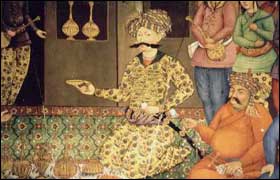| Revision as of 12:28, 3 October 2004 editRoozbeh (talk | contribs)Extended confirmed users6,350 editsNo edit summary← Previous edit | Revision as of 13:29, 17 October 2004 edit undoD6 (talk | contribs)393,081 editsm adding Category:1571 births Category:1629 deaths , see WP:People by yearNext edit → | ||
| Line 20: | Line 20: | ||
| {{1911}} | {{1911}} | ||
| ] | |||
| ] | |||
| ] | ] | ||
Revision as of 13:29, 17 October 2004
Shah Abbas I (شاه عباس اول) (January 27, 1571?-January 19, 1629?) was the most eminent ruler of the Safavid Dynasty. He was also known as Shah Abbas the Great (شاه عباس بزرگ). In early October, 1588 he became shah, by revolting against his father, Mohammad of Safavid, and imprisoning him.

In the midst of general anarchy in Persia, he was proclaimed ruler of Khorasan in 1581, and obtained possession of the Persian throne with the help of Morshed Gholi Ostajlou, whom he later killed in July, 1589. Determined to raise the fallen fortunes of his country, he first directed his efforts against the predatory Uzbeks, who occupied and harassed Khorasan. After a long and severe struggle, he regained Mashhad, defeated them in a great battle near Herat in 1597, and drove them out of his dominions.
He moved his capital from Qazvin to Isfahan in 1592. A few years later, in 1599, the English Sir Robert Shirley directed a major army reform. With his new army, he defeated the Ottoman Turks in 1603, forcing them to give back the territory they had seized, including Baghdad. In 1605 following a victory at Basra he extended his empire beyond the Euphrates; Sultan Ahmed I was forced to cede Shirvan and Kurdistan in 1611; the united armies of the Turks and Tatars were completely defeated near Sultanieh in 1618, and Abbas made peace on very favourable terms; and on the Turks renewing the war, Baghdad fell into his hands after a year's siege in 1623. In 1622 he took the island of Hormus from the Portuguese, by the assistance of the British, and much of its trade was diverted to the town of Bandar Abbas which he had took from the Potuguese in 1615 and had named after himself.
Shah Abbas' reign, with its military successes, efficient administrative system, raised Iran to the status of a great power. Abbas was a skilled diplomat, tolerant of his Christian subjects in Armenia and sending Sherley to Italy, Spain and England in order to create a pact against the Ottomans.
Trade with the west and industry grew. Isfahan became the center of Safavid architectural achievement, with the mosques Masjed-e Shah and the Masjed-e Sheykh Lotfollah; and other monuments like the Ali Qapu, the Chehel Sotoun, and the Meydan-e Shah.
When he died, his dominions reached from the Tigris to the Indus. His fame is tarnished, however, by numerous deeds of tyranny and cruelty, particularly against his own family. Afraid of a coup by his family (as he had done to his father), he locked them up in palaces in order to keep them without knowledge of the outside world. This resulted in weak successors. He killed his eldest son, Safi Mirza, and left his throne to his grandson.
Sources
- The Persian Encyclopedia's entries on "Abbas I of Safavid" and "Mohammad of Safavid"
- Iran Chamber
- See also The Three Brothers, or Travels of Sir Anthony, Sir Robert Sherley, etc. (London, 1823); Sir C. R. Markham, General Sketch of the History of Persia (London, 1874).
![]() This article incorporates text from a publication now in the public domain: Chisholm, Hugh, ed. (1911). Encyclopædia Britannica (11th ed.). Cambridge University Press.
This article incorporates text from a publication now in the public domain: Chisholm, Hugh, ed. (1911). Encyclopædia Britannica (11th ed.). Cambridge University Press. {{cite encyclopedia}}: Missing or empty |title= (help)